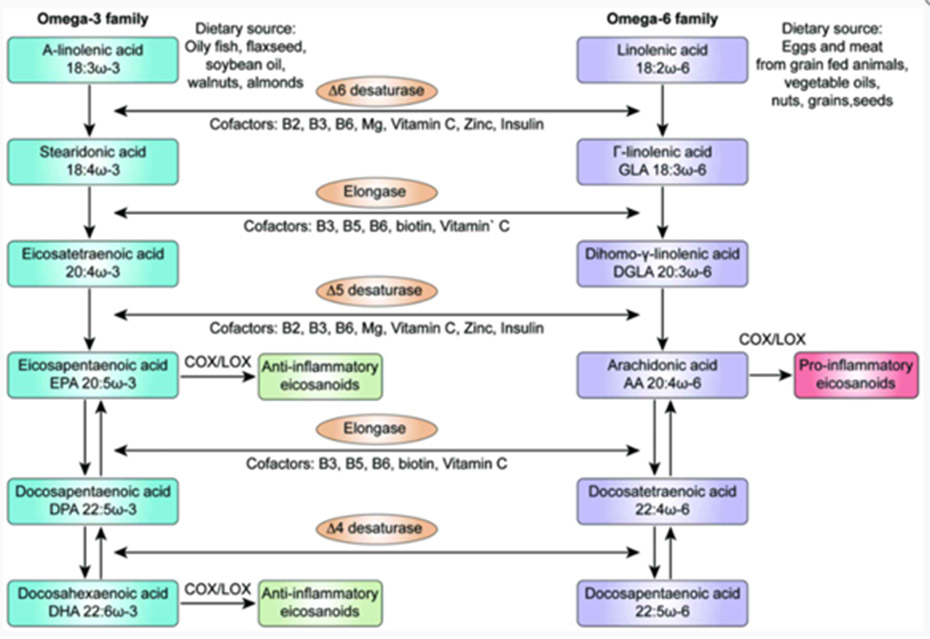As functional medicine providers, we know that omega-3 fatty acids in fish oil have many benefits. The health benefits include inflammatory balance, cardiovascular fitness, brain health, and normal growth and development. We have learned that these benefits come from EPA and DHA. However, new research shows that many of the benefits attributed to EPA or DHA may actually be from a lesser-known omega-3, docosapentaenoic acid or DPA.
Omega-3 and omega-6 fatty acids are considered essential, although in theory, we should be able to make these from their short-chain fatty acids, alpha linolenic acid (ALA) for EPA, DPA and DHA, and linoleic acid (LA) for omega-6s. In humans, the conversion of long-chain fatty acids from short-chain fatty acids is poor, making it necessary for us to consume them as long chain fatty acids. In the recent past, we would consume close to equal amounts of omega-3s and omega-6s in our diet as both short-chain and long-chain fatty acids. This was important since both pathways use identical enzymes to convert them to the active forms EPA/DHA and arachidonic acid and their respective metabolites. Today, the modern-day diet is focused on processed foods that are heavy on omega-6s, both as short- and long-chain fatty acids. High omega 6s “steal” more of the available enzymes for conversion, leaving less for omega-3 conversion. Elevated levels of omega-6s lead to a pro-inflammatory pathway.

Tsoukalas, D., Alegakis, A., Fragkiadaki, P., Papakonstantinou, E., Tsilimidos, G., Geraci, F., Sarandi, E., Nikitovic, D., Spandidos, D., Tsatsakis, A. Application of metabolomics part II: Focus on fatty acids and their metabolites in healthy adults. International Journal of Molecular Medicine. 2018; 233-242. doi.org/10.3892/ijim.2018.3989.
As clinicians, we have counteracted this dietary challenge by prescribing omega-3-rich fish oil. We learned supplementing with omega-3 long-chain fatty acids restores a better ratio of omega-6s and omega-3s and improves overall health. Research has shown the overlapping health effects of EPA and DHA.1 This finding has led to new research looking at the intermediate of EPA to DHA, DPA, as an important source of better health benefits.
DPA will convert in small amounts to DHA, but interestingly, DPA “retroconverts” more regularly to EPA involving the enzyme acyl-CoA oxidase in human fibroblasts.2 In Sprague-Dawley rats, a seven-day supplementation of DPA revealed an increase in DPA and EPA in many tissues but only found an increase of DHA in the liver.3 Recently, a few studies have looked directly at DPA’s impact on human physiology. In a pilot study, 73 patients who had suffered acute myocardial infraction showed low levels of EPA and DPA when compared to controls.4
Another study showed that the levels of DPA in blood platelets have a negative correlation to myocardial infarction in Australian men when compared to men with similar health and higher DPA levels.5 It has been reported that DPA inhibits platelet aggregation better than EPA or DHA, important for atherosclerosis, cerebral vascular and cardiovascular risk.5 In fact, not only does DPA improve platelet aggregation, it also has been shown to improve aortic function in hamsters by inhibiting gene expression of cycloxygense-2 (COX-2).6
DPA also plays a significant role in fetal and child development. Infants whose mothers have higher amounts of DPA in their breast milk and plasma show less incidence of allergic diseases such as asthma and eczema when compared with infants whose mothers have lower amounts of DPA.7 DPA is less oxidized than EPA and is conserved for use in tissues to be used later by the body.7 DPA in tissues throughout the body should considered a reservoir for EPA and DHA.8
The combination of improved omega-3 storage and retroconversion with the physiological effects of DPA demonstrates the need for DPA in the fish oil that you prescribe for your patients.
References
- Kaur, G., Cameron-Smith, D., Garg, M., Sinclair, A. Docosapentaenoic acid (22:5n-3): A review of its biological effects. Progress in Lipid Research. 2011; 50(1): 28-34. https://www.sciencedirect.com/science/article/abs/pii/S0163782710000354.
- Christensen, E., Woldseth, B., Hagve T., Poll-The B., Wanders, R., Sprecher, H., Stokke, O., Christopherson, B. Peroxisomal ?-oxidation of Polyunsaturated Long Chain Fatty Acids in Human Fibroblasts. The Polyunsaturated and the Saturated Long Chain Fatty Acids are Retroconverted by the Same Acyl-CoA Oxidase. Scandinavian Journal of Clinical and Laboratory Investigation. 1993; 215: 61-74. https://pubmed.ncbi.nlm.nih.gov/8327852/.
- Kaur, G., Denovan P., Begg, D., Barr, D., Garg, M., Cameron-Smith, D., Sinclair, A. Short-term docosapentaenoic acid (22 : 5n-3) supplementation increases tissue docosapentaenoic acid, DHA and EPA concentrations in rats. British Journal of Nutrition. 2010; 103: 32-37. https://pubmed.ncbi.nlm.nih.gov/19650956/.
- Oda, E., Hatada, K., Katoh, K., Kodama, M., Nakamura, Y., Aizawa, Y. A Case -control Pilot Study on n-3 Polyunsaturated Fatty Acid as a Negative Risk Factor for Myocardial Infarction. International Heart Journal. 2005; 46(4): 583-591. https://www.jstage.jst.go.jp/article/ihj/46/4/46_4_583/_article/-char/ja/.
- Akiba, S., Murata, T., Kitatani, K., Sato, T. Involvement of Lipoxygenase Pathway in Docosapentaenoic Acid-Induced Inhibition of Platelet Aggregation. Biological and Pharmaceutical Bulletin. 2000; 23(11): 1293-1297 https://pubmed.ncbi.nlm.nih.gov/11085354/
- Chen, J., Jiang Y., Liang, Y., Tian, X., Peng, C., YingMa, K., Liu, j., Huang, Y., Chen, Z. DPA n-3, DPA n-6 and DHA improve lipoprotein profiles and aortic function in hamsters fed a high cholesterol diet. Atherosclerosis. 2012; 221(2): 397-404 https://pubmed.ncbi.nlm.nih.gov/22284366/.
- Kaur, G., Molero, J., Weisinger, H., Sinclair, A. Orally administered [14C]DPA and [14C]DHA are metabolised differently to [14C]EPA in rats. British Journal of Nutrition. 2013; 109(3): 441-448 https://www.cambridge.org/core/journals/british-journal-of-nutrition/article/orally-administered-14cdpa-and-14cdha-are-metabolised-differently-to-14cepa-in-rats/8C08B87EF17C3BEB869F06F286D047EA.
- Li, J., Yin, H., Bibus, D., Byelashov, O. The role of Omega-3 docosapentaenoic acid in pregnancy and early development. European Journal of Lipid Science and Technology. 2016; 118(11): 1692-1701 https://onlinelibrary.wiley.com/doi/abs/10.1002/ejlt.201600076#
:~:text=Docosapentaenoic%20acid%20(DPA%2C%2022%3A,fatty%20acids%20in%20human%20body.

Bill Hogarth, DC, MBS is a licensed chiropractor in the states of Illinois and Missouri. He holds a doctorate in chiropractic from Logan University and a masters in biological sciences from the University of Minnesota. He has been a functional medicine practitioner and educator for more than three decades.



